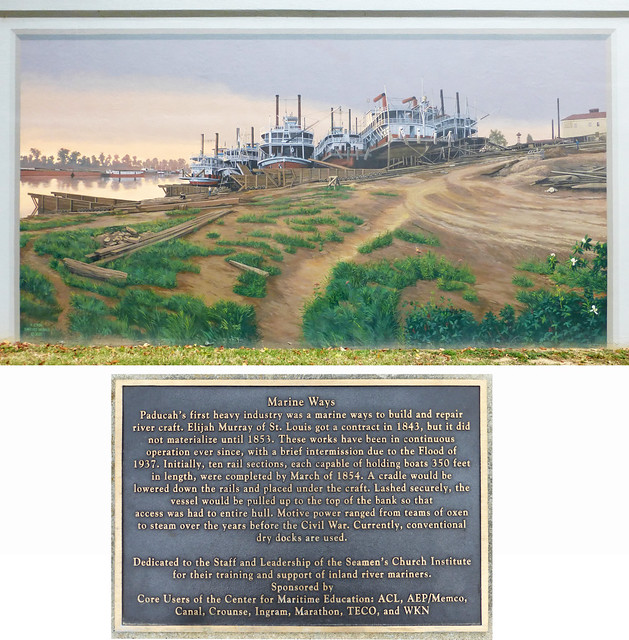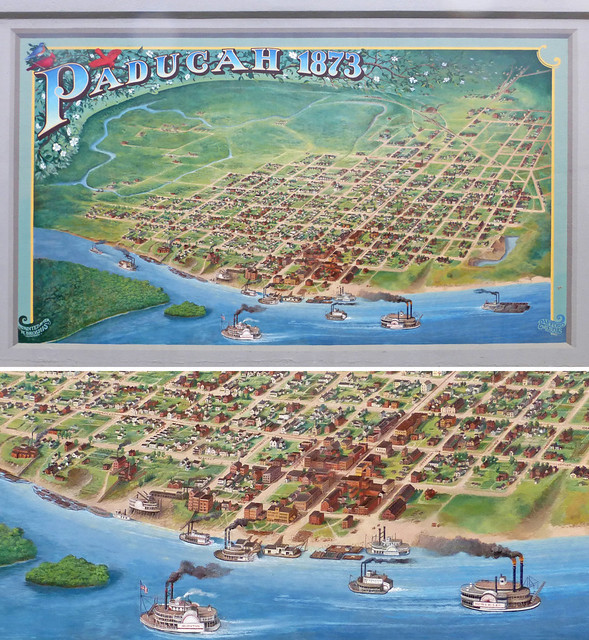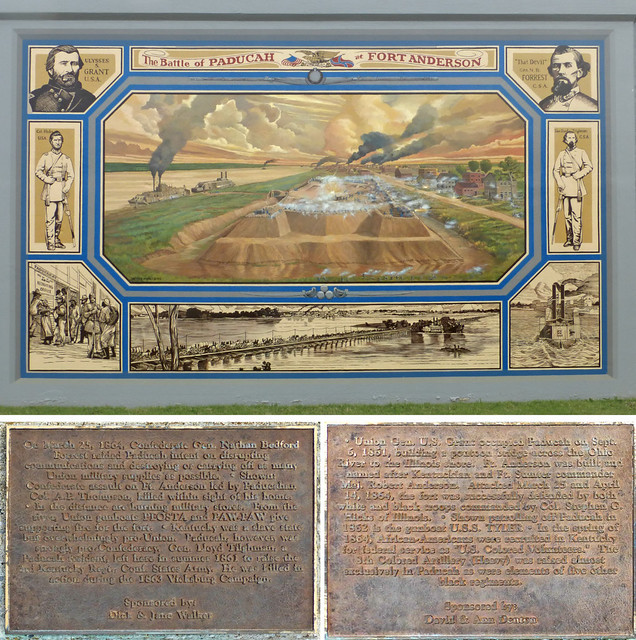Tuesday morning gave us the opportunity to drive downtown to the riverfront in Paducah. The town has a population of about 27,000 and is located at the confluence of the Tennessee and Illinois rivers with a rich history of riverboat and railroad activity. A twenty block area of downtown is designated as a historic district.
A large collection of murals, about a quarter mile in length, has been created on the town's flood wall over the past quarter century. These are worth a detour for anyone in the vicinity. Other attractions such as The National Quilt Museum, likely known to any quilter, the Paducah Railroad Museum (not open on Sunday, Monday or Tuesday), the William Clark Market House Museum and the Inland Waterways Museum all are located near the flood wall murals.
The murals tell the town story over a long period evolving from wilderness to the Atomic Age.
Water Street, along the river, forms the foreground for the murals.
A drive down Broadway passes through the historic district and ends at Water Street.

We took a good look at the river, then walked the length of the murals.




The founding of the town dates back to the Clark brothers: George Rogers Clark, a Virginia surveyor who claimed the land in the late 1790s and his younger brother, William Clark, of Lewis and Clark fame, who returned to found the town and sell lots in 1830.

Riverboats and horses dominated the early history of Paducah as the town grew to something approaching its present size.





As a transportation hub, Paducah held a key position during the Civil War. The murals and plaques depict the complexity of positions for this pro-Confederacy town in a pro-Union (but slave) state.

At about the time of the Civil War, railroads had begun to dominate American transportation, even through river towns.




Paducah became a center for locomotive maintenance for the Illinois Central Railroad, now part of the Canadian National Railway stretching north through Wisconsin and Minnesota into Manitoba.
As the town grew, churches, a synagogue, a Carnegie library and a hospital all took shape.



The river remained important as freight was shipped by barge through the network of locks and dams.
Following World War II, as America built up its nuclear arsenal, a large uranium enrichment plant was built near Paducah along with a huge
electric generating power station. This was one of three such plants
operating in the 1950s and '60s, the other two being the original one at
Oak Ridge, Tennessee, and another at Piketon, Ohio. Decommissioning and
decontamination work here will provide significant employment into the
foreseeable future according to the attendant in the Inland Waterways
Museum.

The Paducah uranium enrichment plant completely transformed the economy of the Paducah area. A 1953 United Press article told the tale:
Western Kentucky farmers have deserted berry patches and orchards for jobs in such industries as the atomic energy plant here.
As a result, fruit production, once the biggest money crop for farmers in the area, has stopped almost completely. In only a few years - since World War II – the area has shifted from a farm economy to an industrial economy.
Many thousands of farmers have taken jobs at the new atomic energy plant, in chemical plants, and with the many other industries that have located in the Paducah area - one of the chief "boom towns" in the country.
The "atomic boom" as it is called locally, is reflected in fact that strawberry production in the Jackson Purchase area has dropped to only 250 acres. In previous years production has totaled 5,000 acres, along with more than 2,000 acres of peach orchards and 1,000 acres of apple orchards.
The MeCracken County Strawberry Growers Association once was the largest strawberry co-operative in the world, and shipped more than 1,000 carloads of berries to northern and eastern markets. Now, the area produces only enough to supply local demand.
Land formerly used for strawberries has become pasture. Orchards have become the sites of trailer camps or subdivisions to house an estimated 20,000 defense workers in the area.

This infusion of jobs and wealth into the Paducah after WWII was, no doubt, influenced by the presence of Alben Barkley in Washington as representative, senator and vice-president. To most modern day Americans, Barkley is only an answer to a trivia question. There was, at one time, an Alben Barkley museum organized in an old Paducah home in 1970, but, as an indicator of how fame is fleeting, it ran out of money and closed the doors in 2008 and the interesting-sounding collection was distributed elsewhere, including some to the nearby Market House Museum.

One final mural caught my eye, depicting the growth of telephone communications in the area. The old "cord boards" here were not replaced until 1979.













No comments:
Post a Comment